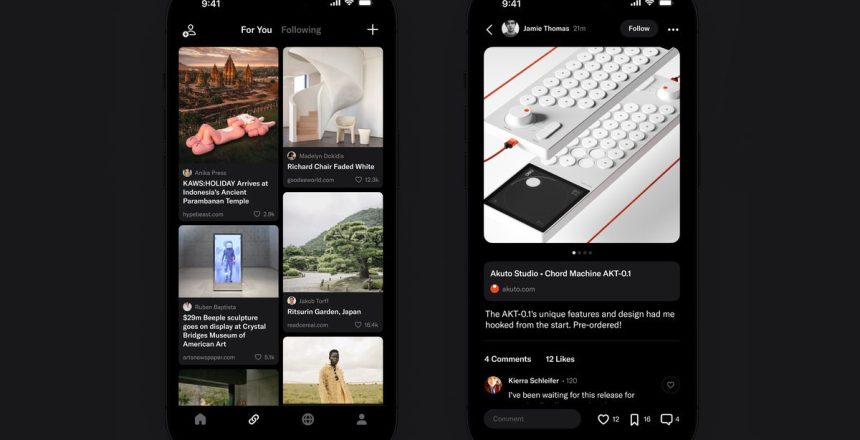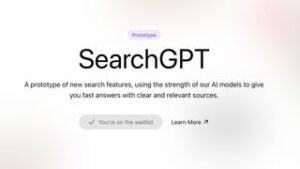/cdn.vox-cdn.com/uploads/chorus_asset/file/24917986/Artifact_Links.jpg)
Artifact, the algorithmic news-reading app started by Instagram co-founders Kevin Systrom and Mike Krieger, was never really meant to just be a news-reading app. Systrom and Krieger have talked about their bigger idea being “TikTok for text,” but so far, all that has meant is a bunch of algorithmically ranked news articles with in-app comments sections. Artifact is a good news app, but that didn’t feel as big as TikTok.
With a new feature called Links, Artifact is getting a little closer to that vision. Links is a new section in the Artifact app, and it’s for far more than news. It’s for, well, links. You can post a link in Artifact to just about anything — an article, a video, a recipe, a real estate listing, a game where all you do is move rocks around — along with a note, a few images, or an AI-generated summary. And if you open the Links tab, you can see the For You page, an algorithmically personalized feed of all those videos, photo blogs, and random ephemera from around the web; or you can switch to Following and see what’s been shared only by people you follow. The new feature is rolling out now to iOS and Android users, though Android users will have to wait a bit longer to be able to post links themselves.
It’s a heady idea, really, and there’s no guarantee it’ll work. Opening an app that shows you an article to read, a hotel a stranger liked, a movie you’ve never heard of, and a recipe for overnight oats could feel like nonsense — or, if each of those things actually speaks to you personally, it could feel amazing. If it works, it turns Artifact into something more than a news app. More than a reading app, even. It would just be a links app. And that’s something different and altogether more interesting.
Systrom says the idea for Links came out of conversations about what Artifact might do with food blogs, or photo essays, or video, none of which felt quite right next to news articles from news publications. But more broadly, the team also longed for something missing on the internet. “I was around way back in the day to witness Digg and all these things,” Systrom says, “when they were more about links and less about news.” He cites Delicious, the social bookmarking app, as another example. There was plenty of news in the mix, but mostly people just shared stuff they liked on the internet. Reddit has some of this energy, too, of course, but it’s not nearly as easy to just traipse through the platform looking for fun stuff. “That kind of went away when social media took hold,” he says. “And nothing’s ever really replaced it.”
There are a few ways to look at Links, all of which Systrom says he’s fine with. One is as a way for people to get their content into Artifact: you can share links to your blog, social posts, or newsletter, and Artifact’s crawlers will figure out what’s on those pages and who might be interested. (Artifact is hoping to be a discovery engine much like the way TikTok can blow up a new creator overnight, though that obviously requires many more users and much more cultural cachet.) Another is basically as an act of kindness: you see a thing, think “more people should see this!” and throw it into the Artifact pile.
Who wants to be a linkfluencer?
But the most interesting thing Links might do is create a new set of link influencers. (Linkfluencers? No? Okay.) People on Artifact might build followings around their expertise or become known for curating really great stuff. It’s a bit like the way Flipboard has embraced magazines and curation over the years, but Artifact is more focused on the person than the publication. Its closest analog is probably when Twitter was at its best and had users who were constantly tweeting and retweeting good stuff into your feed. Like Twitter and other platforms, Artifact will eventually have to answer a crucial question: why would anyone invest in this platform? Systrom seems to hope Artifact can drive traffic to people’s content elsewhere, which is something, but ultimately, incentivizing creators eventually comes down to money. Artifact doesn’t yet seem to know its place in that ecosystem.
Along with the new feature, Artifact is also redesigning its user profile pages. Instead of just showing a user’s comments or a writer’s recent articles, it’ll now also show all the links they’ve shared, plus how many people they follow and are followed by. (It looks a lot like an early Instagram profile, actually, with the image-based grid and the big Follow button.) Artifact is also working on a way to access the app from a PC: Systrom says that might just be a Chrome extension for posting to Artifact, or it could be a more full-blown reading experience, but he knows the app’s curators and posters will want a desktop experience. Just ask the Threads team at Instagram.
Systrom — who obviously knows a thing or two about following-based social networks after so many years at Instagram and Meta — seems torn about how Artifact should approach being a personality-driven app. “The biggest realization in building this product is that sometimes what matters as much as the thing that was shared is the person that shared it,” he says. A few minutes later, though, he says that it’s important for Artifact to always lead with the content; he doesn’t want to create an influencer and celebrity culture so much as he wants to create an endlessly interesting feed of stuff for everyone to see. But when I mention Reese Witherspoon’s book club, which is both content- and personality-based and seems like a perfect thing for Artifact to try and emulate, he says yes of course he’d love to have Reese on the platform. “And then you need people who don’t even know she has a book club, who are like, ‘Oh, that’s in my feed because I love books.’ And now all of a sudden they’re hooked, and they follow her.”
This is where the “TikTok for text” idea is most helpful, actually. “There has to be more use for the TikTok model than just shortform entertainment,” Systrom says. The emphasis on discovery, the content-first presentation, the notion that you can always open the app and be presented with something you’re going to like — why can’t that all work with more than vertical video? Artifact thinks it can.
“There has to be more use for the TikTok model than just shortform entertainment.”
Artifact is going to have to deal with some tricky content moderation questions, of course — now that it’s allowing any URL in the app, Systrom says the team has had to increase its attention on keeping bad stuff from circulating. He says the company uses a mix of AI moderation tools and human review, and while he’s certainly concerned with moderation, “it’s not going to be a large-scale, hundred-million-user-plus problem on day two, I don’t think.”
Systrom says a few times during our conversation that he’s not sure this is going to work. “A place to share links to… whatever” is either going to be hugely compelling or hugely confusing, and he’s not really sure where it’ll land. But he, and the Artifact team, believes that users are missing a place they can just go to find cool stuff on the internet. They hope Links can be that place. And if that cool stuff can be personalized, interactive, visual, and constantly adapting to what you’re interested in thanks to all the advances in AI we’ve had since the days of Digg and Delicious? Even better.





